- Home
- Garden Wildlife
- Arthropods
- Arachnids
- Mites
- Sap-sucking mites
Sap-sucking mites
Most mites in gardens go quietly about their business without coming to the notice of gardeners, but there are spider mites in the family Tetranychidae that damage cultivated plants by sucking sap (or contents of pierced cells) from the foliage. Many feed communally protected by silken webbing, which gives the mites their common name.
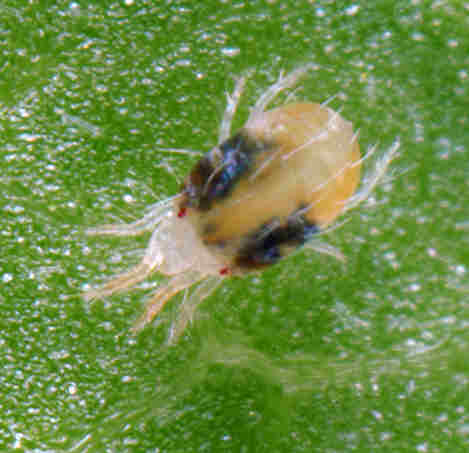
Above left: Sap sucking mite Panonychus ulmi eggs on apple, centre: Conifer spinning mite Oligonychus ununguis right: Sap sucking mite Bryobia praetiosa
Biology
These mites are about 0.6mm in length when fully grown, so are only just visible to the naked eye. They are often present in large numbers on the foliage of host plants, where their feeding causes a progressive loss of green colour from the leaves. Initially they cause a fine pale mottling of the upper leaf surface but later the foliage may become almost completely yellow. Badly damaged foliage can dry up and drop off. Bryobia mites often feed on the upper leaf surface but the other sap-sucking mites live and feed mainly on the underside of leaves. Plants that are heavily infested by spider mites can become shrouded with a fine silk webbing that is spun by the mites. Bryobia mites do not produce silk webbing.
Although some of these sap-sucking mites are commonly called red spider mites, they are generally yellowish green, sometimes additional darker markings. The ‘red’ name is probably derived from the Glasshouse red spider mite, which becomes orange red during the autumn-winter period. Bryobia mites are black with pink legs.
Life cycle
Spider mites and Bryobia mites deposit their eggs on the foliage and stems of their host plants. These hatch into nymphs that resemble the adult mites, except that they have only three pairs of legs. The older nymphs and adults have four pairs of legs. There are often many generations during spring to autumn. Glasshouse red spider mite can complete its development from egg to adult in as little as three weeks in a greenhouse in summer. Most spider mites overwinter as eggs but glasshouse red spider mite overwinters as non-feeding adult females. Bryobia mites can be found on plants throughout the year but are most active during the spring.
Role of sap-sucking mites in gardens
Sap-sucking mites that feed on cultivated plants can cause a significant amount of damage. The most harmful is generally the glasshouse red spider mite, due to its wide range of host plants and its rapid rate of reproduction. It has also been able to gain resistance to many pesticides. Fortunately it can be controlled by purchasing a predatory mite, Phytoseiulus persimilis. Fruit tree red spider mite is mainly a problem on fruit trees that are regularly sprayed with pesticides to control other pests. These sprays often have little effect on the spider mite but they kill the predatory insects and mites that would otherwise be keeping the spider mite at a low level. Spider mites and Bryobia mites that feed on outdoor plants sometimes cause a considerable amount of leaf mottling, which may spoil their appearance, but the plants will survive.
Other sources of information
Website
RHS page on glasshouse red spider mite
Wikipedia page on spider mites
Books
Alford, D.V. (1995) Pests of ornamental trees, shrubs and flowers. Timber Press
Page text drafted by Andrew Halstead, reviewed by Andrew Salisbury, compiled by Steve Head
.jpg)
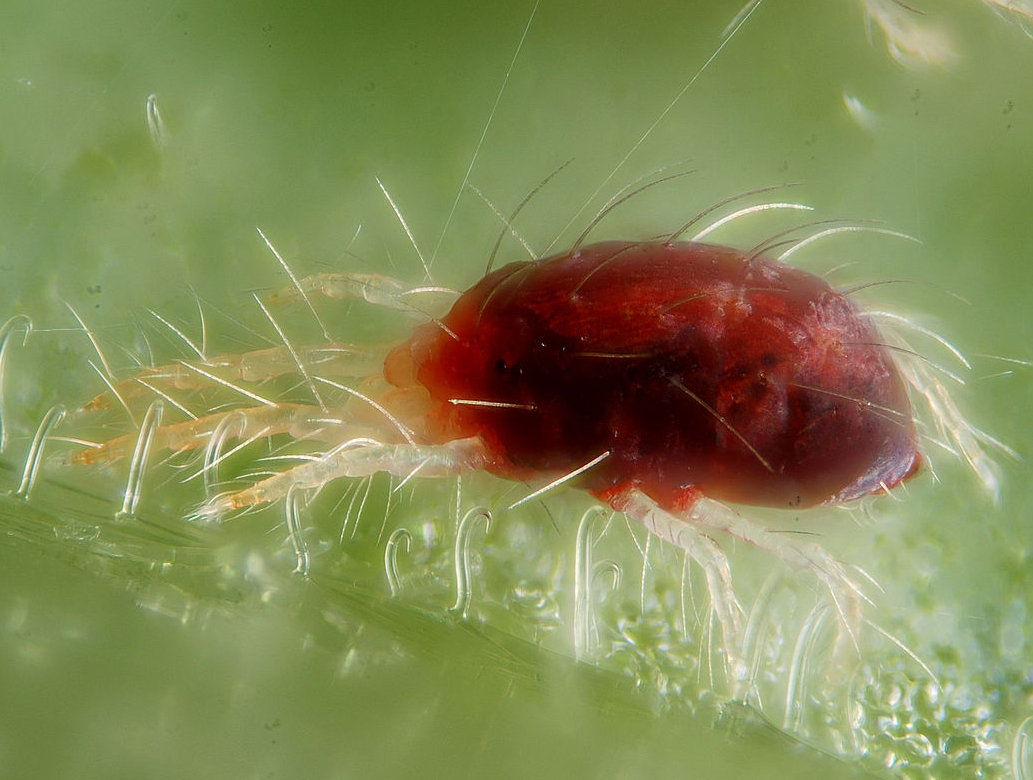
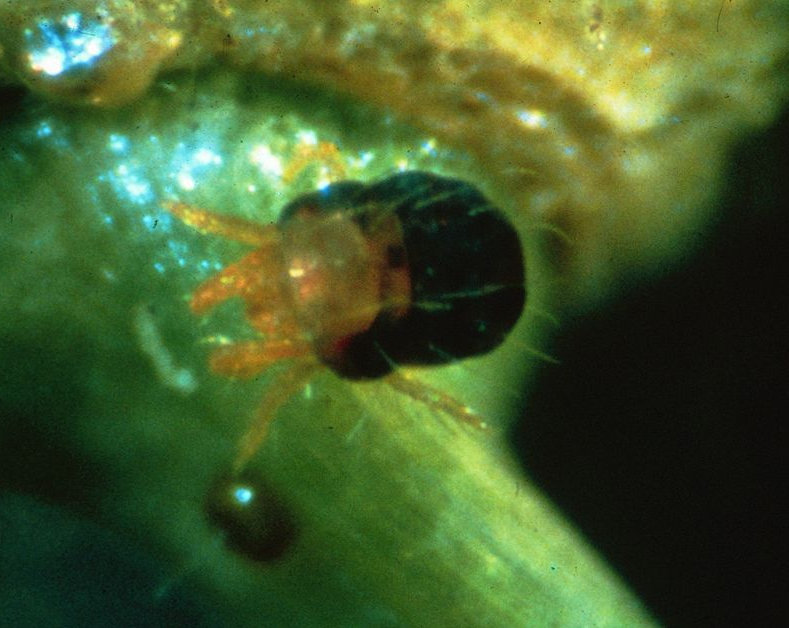
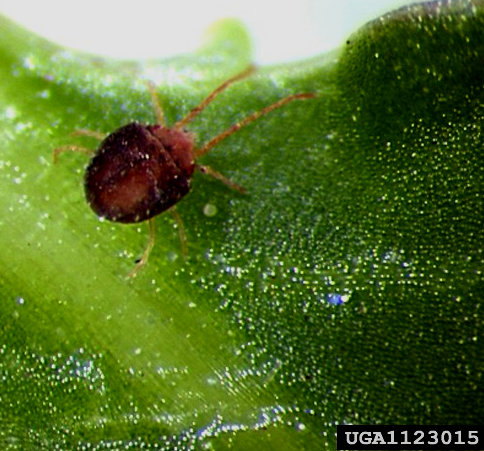
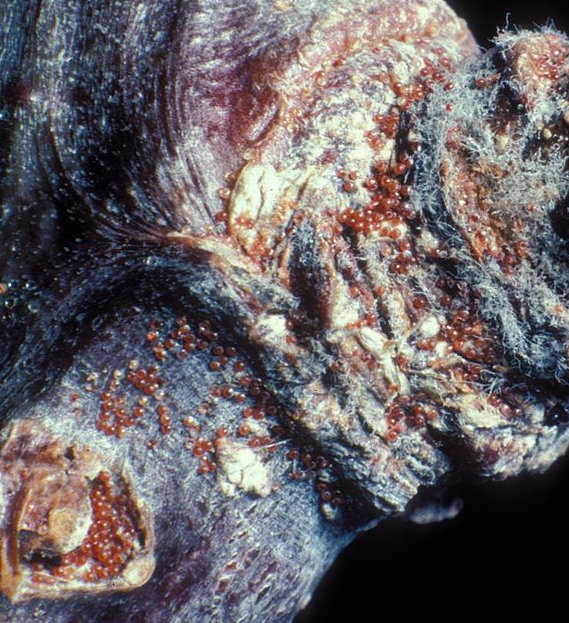
Glasshouse red spider mite Tetranychus urticae red form, green form and a large aggregation.
Species in Britain and Ireland
Glasshouse red spider mite, also known as the two-spotted spider mite, Tetranychus urticae, is the most troublesome species. It feeds on a wide range of greenhouse plants and houseplants. It can also damage garden plants in warm summers. Fruit tree red spider mite, Panonychus ulmi, is a pest of apple and plum trees, as well as some ornamental shrubs. Other sap-sucking mites with more specific host plant requirements include lime tree red spider mite, Eotetranychus tiliarum; box red spider mite, Eotetranychus buxi; beech red spider mite, Eotetranychus fagi; and conifer spinning mite, Oligonychus ununguis, which occurs mainly on spruce, Picea species. Bryobia mites, such as Bryobia cristata and Bryobia praetiosa feed on a wide range of plants, while Bryobia kissophila is confined to ivy.
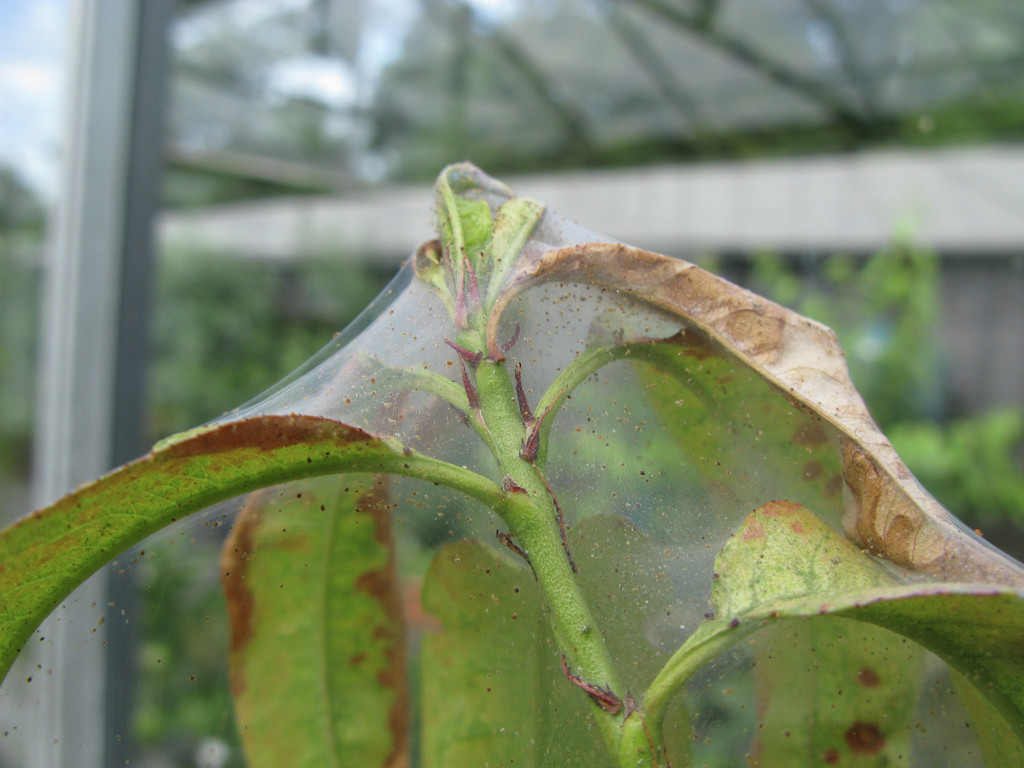
Glasshouse red spider mite silk webbing on peach tree
Sap-sucking mites
Most mites in gardens go quietly about their business without coming to the notice of gardeners, but there are spider mites in the family Tetranychidae that damage cultivated plants by sucking sap (or contents of pierced cells) from the foliage. Many feed communally protected by silken webbing, which gives the mites their common name.
Glasshouse red spider mite silk webbing on peach tree

Species in Britain and Ireland
Glasshouse red spider mite, also known as the two-spotted spider mite, Tetranychus urticae, is the most troublesome species. It feeds on a wide range of greenhouse plants and houseplants. It can also damage garden plants in warm summers. Fruit tree red spider mite, Panonychus ulmi, is a pest of apple and plum trees, as well as some ornamental shrubs. Other sap-sucking mites with more specific host plant requirements include lime tree red spider mite, Eotetranychus tiliarum; box red spider mite, Eotetranychus buxi; beech red spider mite, Eotetranychus fagi; and conifer spinning mite, Oligonychus ununguis, which occurs mainly on spruce, Picea species. Bryobia mites, such as Bryobia cristata and Bryobia praetiosa feed on a wide range of plants, while Bryobia kissophila is confined to ivy.
Sap-sucking mites
Most mites in gardens go quietly about their business without coming to the notice of gardeners, but there are spider mites in the family Tetranychidae that damage cultivated plants by sucking sap (or contents of pierced cells) from the foliage. Many feed communally protected by silken webbing, which gives the mites their common name.


.jpg)
Glasshouse red spider mite Tetranychus urticae red form, green form and a large aggregation.
Biology
These mites are about 0.6mm in length when fully grown, so are only just visible to the naked eye. They are often present in large numbers on the foliage of host plants, where their feeding causes a progressive loss of green colour from the leaves. Initially they cause a fine pale mottling of the upper leaf surface but later the foliage may become almost completely yellow. Badly damaged foliage can dry up and drop off. Bryobia mites often feed on the upper leaf surface but the other sap-sucking mites live and feed mainly on the underside of leaves. Plants that are heavily infested by spider mites can become shrouded with a fine silk webbing that is spun by the mites. Bryobia mites do not produce silk webbing.
Although some of these sap-sucking mites are commonly called red spider mites, they are generally yellowish green, sometimes additional darker markings. The ‘red’ name is probably derived from the Glasshouse red spider mite, which becomes orange red during the autumn-winter period. Bryobia mites are black with pink legs.
Life cycle
Spider mites and Bryobia mites deposit their eggs on the foliage and stems of their host plants. These hatch into nymphs that resemble the adult mites, except that they have only three pairs of legs. The older nymphs and adults have four pairs of legs. There are often many generations during spring to autumn. Glasshouse red spider mite can complete its development from egg to adult in as little as three weeks in a greenhouse in summer. Most spider mites overwinter as eggs but glasshouse red spider mite overwinters as non-feeding adult females. Bryobia mites can be found on plants throughout the year but are most active during the spring.
Role of sap-sucking mites in gardens
Sap-sucking mites that feed on cultivated plants can cause a significant amount of damage. The most harmful is generally the glasshouse red spider mite, due to its wide range of host plants and its rapid rate of reproduction. It has also been able to gain resistance to many pesticides. Fortunately it can be controlled by purchasing a predatory mite, Phytoseiulus persimilis. Fruit tree red spider mite is mainly a problem on fruit trees that are regularly sprayed with pesticides to control other pests. These sprays often have little effect on the spider mite but they kill the predatory insects and mites that would otherwise be keeping the spider mite at a low level. Spider mites and Bryobia mites that feed on outdoor plants sometimes cause a considerable amount of leaf mottling, which may spoil their appearance, but the plants will survive.
Other sources of information
Website
Books
Alford, D.V. (1995) Pests of ornamental trees, shrubs and flowers. Timber Press
Page text drafted by Andrew Halstead, reviewed by Andrew Salisbury, compiled by Steve Head



Above left: Sap sucking mite Panonychus ulmi eggs on apple, right: Conifer spinning mite Oligonychus ununguis
Left: Sap sucking mite Bryobia praetiosa












